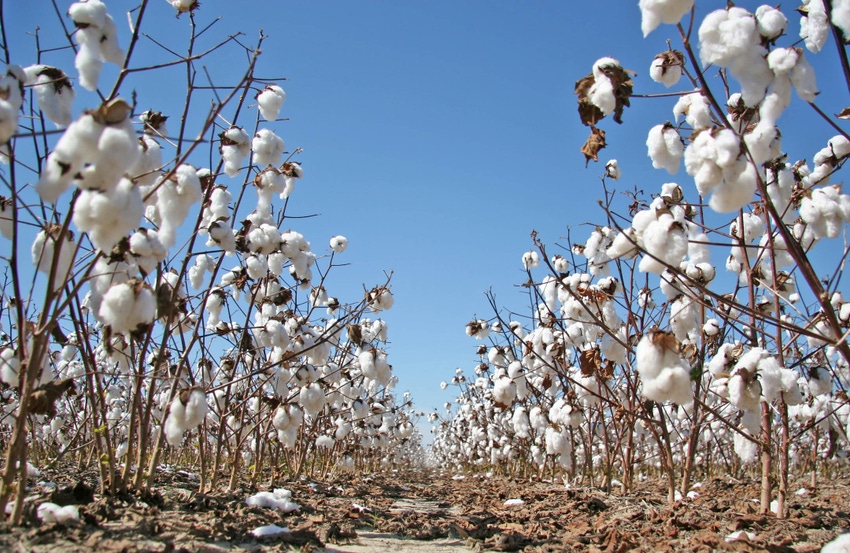
Nematodes: Costly unknown for cotton growers
“The best way to manage nematodes is to be as proactive as possible,” says Tom Allen, associate professor with an Extension and research appointment at the Delta Research and Extension Center at Stoneville. “And the first step in doing that is to sample, sample, sample, sample — I can’t emphasize this enough."

Many Mississippi cotton producers have nematode problems that are costing them yield and dollars, says Tom Allen, yet they often may not know they have the pests, or if they do they may not be correctly managing for them.
“I’ve been beating the drum about this,” he said at the annual Mississippi State University Producer Advisory Council meeting, attended by producers from counties in northern Mississippi.

BYRON WILSON, from left, Houston, Miss.; Dee Suitor, Corinth, Miss.; and Mark Crenshaw, Mississippi State University Extension professor of animal and dairy science, were among those attending the North Mississippi Producer Advisory Council annual meeting.
“The best way to manage nematodes is to be as proactive as possible,” says Allen, who is associate professor with an Extension and research appointment at the Delta Research and Extension Center at Stoneville.
“And the first step in doing that is to sample, sample, sample, sample — I can’t emphasize this enough. This is how you find out where you have a problem.
“I know analysis of a soil sample will cost $11 per sample at the Mississippi State laboratory, but it’s worth it. If you have a nematode problem in your cotton fields, you could easily be losing the cost of the soil sample in yield.”
Allen says growers should be aware that different labs have different methods of reporting the soil sampling results when it comes to the number of nematodes per amount of soil analyzed.
“The Mississippi State lab looks at a pint of soil, which is equal to almost 500 cc of soil; other labs may use 250 ccs, and some use 100 ccs. So, when you get your lab report, make sure you know how much soil was used before you consult a nematode threshold. Then you can calculate your numbers and determine how those fit into the published nematode thresholds.”
Also, he notes, numbers will differ for samples taken in the spring, mid-season, or fall, as well as for different soil classifications. “Keep in mind that root-knot nematodes prefer sandier soil, while reniform nematodes prefer soil with more silt characteristics.”
Rotation is best strategy
There are, Allen says, very few commercially available cotton varieties with some level of nematode resistance, “and even that is going to be more toward the level of tolerance — for root-knot nematodes only. At present commercially available varieties with tolerance to reniform nematodes are not available.
“One of your best nematode management strategies is to plant a rotational crop, depending on nematode species present. Grain sorghum is a good alternative, because root-knot nematodes also go to corn and soybeans. Grain sorghum is also a good alternative for reniform nematodes. But, if you have reniform nematodes present, corn is a good alternative.
“If you have root-knot nematodes in corn, you may not see a substantial yield drag, or if you pull up a corn plant, you may not observe galls indicative of a root-knot problem. But corn will increase root-knot nematode populations. Your best bet is to stick a probe in the ground and send a sample to a lab for analysis.”
Aside from that, Allen says, “You can try and find a cotton variety with some tolerance, but some of the varieties may be so new there won’t be a tremendous amount of information available.”
A number of growers have asked about seed-applied nematicides, he says. “I don’t know of many researchers who have a good data set on this. But with the nematode numbers that we’re consistently seeing in some Mississippi cotton fields, seed-applied nematicides are not doing the job growers are expecting them to do.
“Fumigants are another potential management strategy, but they have their fit in specific areas. Where you know you have a nematode problem, based on field maps, yield maps, soil classification types, general poor performance, etc., your best bet is going to be site-specific management. You don’t want to spend $50 per acre across a 3,000-acre farm treating with a fumigant for something that may be a problem on only 5 to 15 acres.
Telone a good tool
“Based on trials we’ve conducted, you can get an excellent response from Telone — as much as a 200-pound increase in seed cotton when high root-knot populations are present.
“Telone works, I’m a big believer in the product. In all the trials we’ve had, it looks great, if used in a site specific management program in areas where nematodes are a problem.
“If you look at the yield across a large area, such as by collecting entire treated strips in a boll buggy, you’re not going to see a difference. You’ve got to look at small areas within a field to see how it’s performing. Fumigants won’t provide season-long prevention, but they will provide enough prevention that you’ll decrease nematode numbers and improve yield.”
It’s hard to get a handle on how much product is available from year to year, Allen says.
“There is no distribution point in Mississippi for Telone, and there are only two to three applicators in the state that I know of, so we don’t currently have the ability to cover a lot of acres.”
Foliar applications of Vydate “will reduce root-knot nematodes a little bit. But you’re trying to manage a root pest with a foliar application, and I haven’t seen data that suggest this practice gets outstanding results.
“If you wanted to use Vydate with a seed-applied nematicide and a fairly tolerant variety, that might be a good integrated approach. The problem is, very little data are available to suggest how effective this type of integrated practice would be.”
About the Author(s)
You May Also Like



